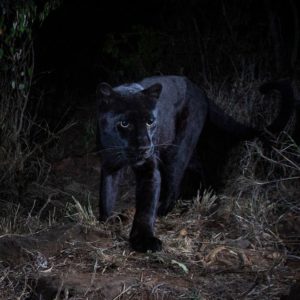
Black Leopard Spotted In Kenya For The First Time In 100 Years
Many people thought that the African Black Leopard was a myth, but recently photos went viral that showed the exotic cat alive and well in Kenya.
Nick Pilfold from San Diego Zoo who is a global conservation scientist said that a group of biologists shot the photos and footage of the extremely rare cat, they waited months for the moment.
There were sightings before but no one was able to capture photos or even videos of their allegations, but after the team captures the photos it showed confirmation that it does exist.
Nick Pilfold said: “It is likely that black leopards have been living in Kenya all along, it is only that high-quality imagery to confirm it has been missing until now.”
The sighting of the Black Leopard was published in the Journal of Ecology Africa.
A news agency from Kenya also said that Phoebe Okall shot an image back in 2013 that showed the black leopards existence.

Nick Pilfold said that he knows that there are a couple of photos that have been taken over the past years, but he says that all the photos were taken from a far distance and could not be used as a piece of evidence to prove the existence of the black leopard.
The image that was taken by Phoebe Okal, in particular, is a captive black leopard that was brought from America as a kitten to Kenya, not wild.”
Nick Pilfold said: “Prior to the observations in our published paper, the last confirmed observation (in the published record) was 1909 in Ethiopia.”
The team shot a footage and some photos as the cat was roaming around in the dark, you can see its eyes shine like marbles in the dark.
Pilfold said that the team placed remote cameras on certain locations that can help them keep track of the population of leopards in the area of Laikipa Country and in the hopes they could find the black leopard.
Nick Pilfold said: “We intensified our camera placement in the area the reports were being made, Within a few months, we were rewarded with multiple observations on our cameras.”
Even though there have been numerous sightings of black leopards in the continent, they are still considered rare and according to some, this is the first time in 100 years that there has been an official sighting of the rare cat.
The color of the leopard is a result of melanism, a mutation in the genes that causes an over-production of the pigment. The melanism is the opposite of albinism, and even though the color of the leopard can be seen during the day, but its rosette patterns are easily visible during the nighttime through infrared imagery.
Nick Pilfold said: “Melanism occurs in about 11 percent of leopards globally, but most of these leopards live in South East Asia.”
Here are more of my black leopard photos. What a stunning animal! I have shared a few more on instagram as well https://t.co/JNNq5eJ035 pic.twitter.com/cQAQPFQd6N
— Will Burrard-Lucas (@willbl) February 13, 2019
The photograph was taken by Will Burrard-Lucas, he called said that it was his longtime dream that came true.
He said this on his blog: “For me, no animal is shrouded in more mystery, no animal more elusive, and no animal more beautiful, For many years, they remained the stuff of dreams and of far-fetched stories told around the campfire at night. Nobody I knew had ever seen one in the wild, and I never thought that I would either.”
He used the Camtraptions camera to shoot the images at the Laikipia Wilderness Camp, the camera is known and is used more in wildlife photography. The cameras were positioned in those places where the leopards were seen and where water sources like natural springs and pools were near.
According to the African Journal of Ecology, the cameras were on for 24 hours a day in most of the places they were placed in but were only turned on night times in the public places.
The Leopards are labeled as critically endangered on the list of the International Union for Conservation of Nature’s Red List of Threatened Species.
Factors like hunting, habitat loss, conflict, and competition for prey has decreased the population of leopards in the continent. The total number of decline is still unknown.
Paula Kahambu a Kenyan Conservationist said that there have been many sightings of black leopards but this was the first time someone got photographs and even a footage of the extremely rare cat.
Paula Kahambu said: “Despite many challenges in the sector, Kenya’s wildlife continues to awe and inspire the world, I hope that this rare find persuades the authorities that we must balance conservation with development to protect our spectacular and mysterious species.”
Paula Kahambu congratulated Letouluai for helping lead the project, and said: “I hope it inspires a new generation of Kenyan wildlife scientists.”